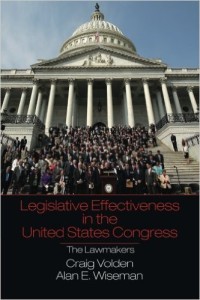A New View on the U.S. Congress
Written by Craig Volden, Associate Dean for Academic Affairs, Frank Batten School of Leadership & Public Policy, and Lifetime Learning’s HooReads! featured author
Americans are dismayed with their government in Washington. Their approval of the job that Congress is doing hovers around record lows. Many major policy problems are going unaddressed. And members of Congress seem more interested in electioneering than in governing. Even within the majority Republican Party, divisions have grown so great as to lead Speaker of the House John Boehner to resign.
It is easy to attribute policy gridlock to partisanship, divisiveness, and polarization. With divided government between Congress and the President, and with a wide gulf between conservative Republicans and liberal Democrats, there appears to be little room for compromise.
And yet, in any two-year period between elections, Congress passes hundreds of laws. Because they tend to be on smaller day-to-day issues, these compromises and agreements do not receive much media coverage or notice from the public. But these smaller successes do point to the idea that some members of Congress are still interested in governing, and some are quite good at it.
Just as some big league pitchers outperform others and some college quarterbacks are ranked more highly than others, so too are there measurable differences in the effectiveness of members of Congress. In my research, I have developed a method for scoring each member of the House of Representatives based on how far their sponsored legislation moves through the lawmaking process and on how important their proposals are.

In our new book Legislative Effectiveness in the United States Congress: The Lawmakers my coauthor (Alan Wiseman at Vanderbilt University) and I use these scores to take a fresh look at how Congress works and what policies it produces. We show how party leaders bottle up opposing proposals in committee. We explain why women have been more effective lawmakers than men. We trace the ineffectiveness and fall of the Southern Democrats in the 1980s and 1990s.
We also identify the 20 most effective lawmakers from the past 40 years, and identify the habits that they used to get things done in Congress. Those habits include: perseverance, despite the reality that 96% of legislative proposals fail; coalition-building, even with members of the opposing party; and entrepreneurship in using their positions of institutional strength.
One thing that surprised us in our analysis was that these effective lawmakers were able to achieve widespread support for their proposals, even in recent polarized Congresses. On average only a handful of members in the opposing party voted against the proposals of these most effective lawmakers.
Moreover, we find that the members who are effective in one Congress are more effective in the next, and more likely to bring about new landmark legislation. If we as a country are hopeful for significant policy change, we need look no further than the members already in Congress who exhibit lawmaking effectiveness and offer them additional support.
Unfortunately, however, most members of the public lack the information needed to evaluate their representatives. At best, they rely on what the members themselves say – a clearly biased source. Instead, citizens can look up their representatives on our website www.thelawmakers.org, to determine whether they are represented by effective or ineffective members.
As we head into the 2016 election year, we can continue to complain about business as usual. Alternatively, we can start to demand more of our representatives. We can hold accountable those lawmakers who are neither willing nor able to be part of the solution, who are not being effective in their lawmaking roles.
- Stay on Track: Turning Resolutions into Results
- From “Jimmy Who?” to “What Would Jimmy Do?”
- Washington’s Bold Gamble: Christmas Day 1776
- UVA Club of Pasadena: Cavs Care Gathering at the Raymond
- UVA Club of Boston: UVA Men's Basketball Game Watches
- UVA Club of Richmond: Tour of the Valentine Museum

